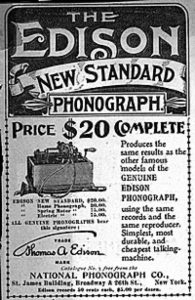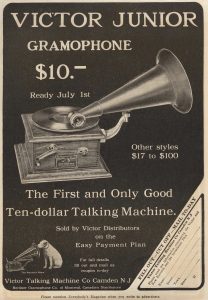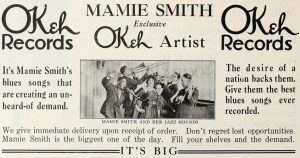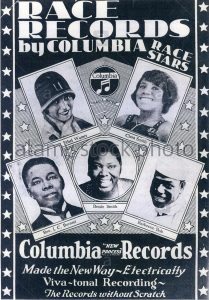6 The First Format War: Cylinder vs. Disk
Thomas Edison invented his famous wax cylinder recording device in 1877. However, twenty years earlier, in 1857, the French Academy of Sciences issued a patent for a device known as the phonautograph to Edouard-Leon Scott de Martinville that was based on a similar principle of etching sound waves onto a medium that can then reverse the process and replay those etchings. Martinville never produced a working prototype of his phonautograph, but in 1874 a young Scottish immigrant to America, Alexander Graham Bell, built a prototype of the device from Martinville’s patent descriptions, thus giving the world the first audio recording device, three year’s before Edison’s. Bell did not focus on recording technology, as he became distracted by the promise of his work inventing the telephone, which incorporated Bell’s new invention, the electric audio transmitter, or microphone. (The microphone, of course, would later become essential to audio recording, but not until about 50 years later.) Bell’s telephone had more obvious practical applications than a recording device, so it understandably received much more commercial attention. Thus, Bell became famous for the telephone rather than recording, even though he had made a working recording device before Edison. And Edison became famous for recording, even though his device was not technically first, because he devoted time to marketing it.
Bell’s interest in Martinville’s first recording device patent would later resurface when Bell made improvements to Edison’s “talking machine” (including a floating, rather than fixed, stylus; wax recording media rather than foil; and in-ear stethoscope audio playback for increased audio fidelity). Bell’s patents for what he called the Graphophone would later be purchased by Edward Easton who used them to produce a line of records he sold under the name of the first dedicated record company — Columbia Records. By 1890, Columbia had a 10-page catalog of musical recordings for sale. Columbia’s biggest hit from this period was a novelty song, “The Whistling Coon,” recorded by a former slave, George Johnson (you can listen to it on YouTube). This gives an early indication of the importance African-American musical style and performance would have on the recording industry throughout the 20th century, and how those black performers also had to overcome racial stereotypes as they became increasingly involved in the industry.
Edison started the Edison Phonograph Company in 1887 to manufacture and market his cylinder-based “Edison Home Phonograph.” The device sold well, but because of the low audio quality, its usefulness for music reproduction was not obvious and it was regarded as mostly a novelty. So, in 1888, Edison sold the company, including his patents for the device, and the company changed its name to the American Graphophone Company.
Edison’s cylinder design was eventually upstaged by German immigrant Emile Berliner’s competing “gramophone” disc recording technology, which Berliner patented in 1887. The primary advantage of the gramophone was that the technology incorporated a method of easy duplication: chemically etched metal disks were used to stamp duplicate copies. These master stamping discs were found to work best when made of gold, so the famous “gold records” awarded to records selling 100,000 copies are based on the actual historical origins of that technology. Edison’s cylinders, by contrast, could only be duplicated by recording multiple original copies or copied laboriously using a pantograph. Berliner’s flat discs were also more easily stored and could be recorded on each side. Berliner’s discs also used horizontally-cut grooves rather than the vertical grooves of Edison’s cylinders. Berliner expanded internationally as well, starting Deutsche Grammophon in Germany and the Gramophone Company in England.

After Berliner’s and Bell’s success in improving the audio quality of recording devices, Edison in 1896 succeeded in legally regaining the rights to his early patents, which enabled him to resume manufacturing players and cylinder under the name National Phonograph Company. His release of recorded cylinders offered competition to Columbia, which quickly resulted in lower prices for both recorded cylinders and players, drastically expanding the market and accessibility. By 1898, the price of a cylinder player had decreased from $150 (in 1891) down to only $20 for the standard model and $7.50 for the least expensive model (the Gem)!
In a series of complicated legal challenges that would come to define the recording industry to this day, Emile Berliner lost control over his patents and his company in 1900, effectively shutting him out of the American recording industry his invention had helped launch. As a result of these legal battles, the newly-formed Consolidated Talking Machine Company began manufacturing discs under the name Victor Talking Machine Company in Camden, New Jersey. In 1901, Victor launched its line of gramophone players and 10-inch discs rotating at 78 revolutions per minute, the format that quickly became standardized across the industry. Victor was known for its trademark image of Nipper, the fox terrier, listening with cocked ears to the horn of a gramophone.

Columbia, now realizing the cylinder was becoming antiquated, began distributing its own line of 10-inch discs to keep up with Victor. By 1903, Columbia and Victor had pooled their patents with a cross-licensing agreement to create an effective monopoly on laterally-cut discs. This was the first of many industry consolidations that continue to define the recording industry today. As we will see later when discussing the details of recording contracts, music recording is a risky venture that requires significant investment of up-front capital with statistically low returns on that investment for the vast majority of recordings. The capital requirements and high risk of record production favor pooling of resources and corporate consolidation. By 1907, Victor had a catalog of over 7,000 titles and had sold over 500,000 of its cutting-edge “Victrola” disc players which featured an “internal horn” rather than the iconic external horn of earlier designs. By 1921, Victor was selling over 50 million discs per year.
Until the mid-1920s, recordings were made using an “acoustic” or mechanical process (that is, non-electric). Musicians and singers would array themselves in the recording studio around a large horn (or sometimes multiple horns) that funneled the sound into a recording diaphragm that vibrated a cutting needle, which in turn etched a groove onto the surface of a wax disc. That disc then became the mold for creating a metal master disc, from which duplicate discs were pressed. The sound quality of these acoustic recordings was far inferior to the electrical recording process that would become the norm by 1927.
The mechanical recording process favored louder instruments and voices in the “tenor” range, and was particularly unfriendly to low bass frequencies. Accordingly, some musical styles were better suited to this new technology than others. Italian opera star Enrico Caruso made the first record to sell one million copies in 1904 on the Victor label, his strong tenor voice being perfectly suited to the limitations of early recordings. Victor’s success came primarily through sales of “serious” music, such as Caruso’s many opera aria recordings. Victor’s musically conservative approach, however, would lead to opportunities for other companies to fill the void in recording popular styles. The story of the recording industry would be dominated throughout the rest of the 20th century and into the 21st with this repeating trope of major record companies being challenged by smaller “independent” companies that could take musical risks with new genres.
In 1911, the recording industry witnessed what might have been the first international recording pop sensation when four different recordings of Irving Berlin’s dance hit, “Alexander’s Ragtime Band,” each managed to chart in the top-five. Two of those recordings were made by the vocal duo of Arthur Collins (baritone) and Byron Harlan (tenor), one on Victor and one on Columbia, indicating the now highly unusual aspect of early recording contracts which did not demand exclusive rights (more on this when we discuss recording contracts). The phenomenal success of this and other early syncopated dance hits gives an indication of where the industry was headed.
By 1914, the first “blues” recording (W.C. Handy’s “Memphis Blues”) had been released by both Victor and Columbia, followed five years later by the first “jazz” recording, “Livery Stable Blues” (Victor, 1917). These early releases of blues and jazz were an indication of America’s embrace of African-American musical styles in the 1920s and a corresponding expansion in the recording industry. Given Victor and Columbia’s focus on proven Tin Pan Alley composers and hesitation to record black artists, the stage was set for new companies to seize opportunities to expand both the styles of music recorded and break down color barriers in the industry. A handful of new “alternative” or “independent” record labels rushed to fill these voids in the major labels’ catalogs: Okeh, Brunswick, Aeolian-Vocalion, Paramount, Gennett, and Black Swan are among the best known. Of these, Black Swan stands out not only for its recordings of black artists, but for the fact that it was the only black-owned record company of the time.

In 1920, Okeh records started the ball rolling with the dramatic success of its recording of black blues singer Mamie Smith, singing “Crazy Blues,” a song written by black songwriter Perry Bradford. Although this was not the first commercial recording of a black singer, it was the first commercially successful vocal blues recording by a black singer. This recording was remarkably successful, selling over one million copies within a year! “Crazy Blues” ranks as one of the most iconic successes of the music industry in the 20th century, proving there was an untapped market for recordings by black performers among a underserved demographic of black (as well as white) consumers who wanted to hear the latest styles, not just opera or novelty songs. “Crazy Blues” immediately opened the floodgates for other record companies to find their own black blues singers to attempt to duplicate that success.

By 1923, Columbia records had found its own star, Bessie Smith, who would go on to become the most celebrated of the black “blues queens” of the 1920s. Her 1923 recording of W. C. Handy’s “St. Louis Blues” on Columbia is considered one of the most iconic recordings from the era. Other labels found their own blues queens, and the ‘20s became known for the glamorous and simultaneously gritty sexual realism of the blues queens. Ironically, by the 1960s the blues queens would largely be forgotten and the blues became synonymous with the rural sound of the black male blues singers of Mississippi in the 1930s, such as Robert Johnson. Those early rural blues recordings failed to sell in any significant numbers when they were made in the 1930s, but would later become an object of intense fascination for young white rock musicians looking for a new mode of musical to expression.
Despite the real progress of record companies selling recordings of black performers singing blues songs written by black songwriters (sometimes even on black-owned labels), the record industry in the 1920s still reflected the racially-segregated reality of the time. Records of black performers in the ‘20s were uniformly marketed as “race records” so the buying public would know the skin color of the performer. Record companies marketed race records to black audiences and assumed white audiences were not interested. Further, records were never made of performers of different races performing together (or at least not openly), as record companies were not willing to cross that barrier until the 1930s. Of course, many white record buyers wanted to hear these new black artists, so the record-buying public was, as would always be the case, one step ahead of the industry.
One striking example of the firm color line in the record industry in the 1920s is a series of 1929 recordings issued by Okeh records of a guitar duo of black guitarist Lonnie Johnson performing with “Blind Willie Dunn.” However, there was in reality no such guitarist named Blind Willie Dunn. The second guitarist was actually white jazz guitarist Eddie Lang, but the racial sensitivity of that time prevented Okeh from issuing a recording of a black guitarist playing with a white guitarist. These may have been the first such commercially available integrated records ever made, but that fact was hidden from public view by the use of Lang’s pseudonym.

